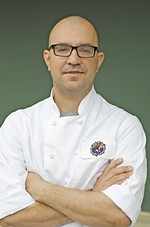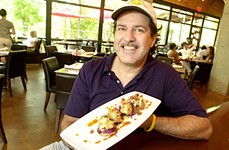Leader of the Pack
An Interview With the Head Coyote
By Robb Walsh, Fri., July 14, 1995
I interviewed Miller recently over a plate of bad fajitas on Austin's Eastside. Here's what he had to say:
Austin Chronicle: You're the first celebrity chef to venture into this market. Why Austin?
Mark Miller: Austin is the state capital of the second largest state in the United States. It's a young town; it's growing and vital. The high-tech industry is evolving here. There're a lot of highly educated people with good income coming in. You don't want to buy a stock when it's peaking; you want to buy it on the way up.
AC: So you're buying Austin on the way up?
MM: I think so. Besides, I've been coming to Austin for 15 years and there's always been a lot of food excitement here. I think it's always been a food city; whether it's the Austin Hot Sauce Contest or the Hill Country Food and Wine Festival, people here have always been interested in food.
AC:So how come none of the big Texas chefs, like Stephan Pyles or Robert Del Grande, have come into this market?
MM: I don't know. I asked Stephan and Robert if they were interested in Austin and they said, "No, Austin is too cheap." There is so much good inexpensive food that's available here, they thought they couldn't compete.
But I thought, someone's going to move in here. And there are other people who are looking at Austin: Jimmy Schmidt's [the highly acclaimed chef at the Rattlesnake Club in Denver] looked at it; Bobby Flay [the executive chef and owner of the Mesa Grill in New York] looked at it. And now that we're here, you'll see the market heat up a little bit.
AC:That's good for us.
MM: People have asked me to do Coyote Cafes in New York and L.A., but I didn't want to do that. I want my restaurants to have a cultural connection to the community. That's why we came to Austin.
I love the organic produce that's being grown here. I'm thinking to myself, "God, it's so much easier to come in here than it was to come into Santa Fe." I had nothing in Santa Fe. There were no good restaurants, no suppliers, no farmer's market, no organic farming. I was in a town of 50,000 people where 49,000 couldn't afford to come into my restaurant.
AC:You really set off a flap in Santa Fe when you first arrived, didn't you? Didn't you tell somebody there that you weren't interested in the food their grandmother cooked, you were more interested in what the Indians were cooking in the Fifth Century?
MM: [laughing] When I first moved there, I went to see the great restaurants of Santa Fe and I'd see a chef take a number 10 can of El Paso red chile sauce and use it as a base for his sauces. I thought, "Jesus Christ, there is no New Mexican food here." I mean it's all hype. All these people who were Hispanic and were so proud of this food and you go and ask them which chiles they grind up to make this dish and they'd say, "We just open this can of chile sauce and mix it with this canned tomato sauce and pour it over the top." I had to go looking for the true Chimayo chile and hire farmers to grow it for me. And then people came up to me and said, "You can't call this traditional New Mexican food." I said, "What you think is traditional is what your mother and your grandmother cooked." I said, "I'm more interested in what people were cooking 2,000 years ago, the people who actually lived here, centuries before the Anglos came."
AC:So what's the reaction to Coyote Cafe in Austin so far? Have you started any flaps yet?
MM: Yeah, with the cowhide chairs. What I saw last night, it was the first time I looked at the dining room, is that we're getting this huge mix of people, people in shorts, well dressed people, Mexican folks; it's very difficult to get a read on this community. It's such a diversified community. It's much more heterogeneous.
We are adjusting. We kind of went a little too elegant, I think. The food needs to be heartier. We need to do something more like what Rick Bayless is doing with Frontera Grill. People are not so nouvelle oriented in Austin; they have big appetites here. They also don't order Texas wines and they hate our cowhide chairs.
AC:Why do they hate the cowhide chairs?
MM: It was a funny thing. Three or four women, animal activists, refused to sit in the cowhide chairs. You know, we didn't use plastic on purpose. The banquettes are real leather. It's kind of a trademark. But these women made a big deal of refusing to sit in the chairs. I mean, I'm sorry lady, but we wear leather shoes, too. What are you supposed to do with the skins after you kill the cow, are you supposed to throw them away?
But most people seem to like the decor overall. It's better than 612 anyway - I mean, that was one of the ugliest restaurants I've ever been in. It was really hard, it wasn't soothing or comfortable. It wasn't welcoming. I was surprised because Austin people don't seem to want to dress up to go out and 612 was so modern. Dick Clark [the architect of 612] has been bad-mouthing us about what we did to his great masterpiece.
AC:Well, he did win some architectural awards for it....
MM: Yeah, but the sight lines, looking straight into the kitchen, and the noise levels - he designed it from a purely visual sense of architecture. I have to design things based on the comfort of the guests. What do they want to hear and see?
AC:When I lived in the Bay Area, I used to hang out at your first restaurant....
MM: Fourth Street?
AC: Yeah. It was 1981 in Berkeley and it was the first time I ever saw innovative food done with Mexican ingredients, the food that would later come to be called Southwestern Cuisine. Your Yucatecan sausage...
MM: That was great sausage!
AC:...and your use of cilantro, it was all new to me.
MM: You know, Fourth Street is probably a better model for the kinds of things we ought to be doing in Austin now. Even though it's a restaurant I started 15 years ago, the food was heartier and the menu was more experimental than what we do in Santa Fe or what we do in Vegas, which are different markets....
AC: Which are tourist markets.
MM: That's right. We don't know what we're doing here yet. The fact is, I will adjust the food and the decor and the drinks. You know, people here like their drinks sweeter and they don't like the food as hot. Fifty people the first night complained about the yellow chile pasta, 50!
AC: That's funny; here in Austin, we think of ourselves as liking our food really hot.
MM: I know. But the food is hotter in Santa Fe and Vegas. Our chefs thought, wow, this is Austin, let's really give it to them! But people here didn't like it. They like a long, slow burn, not a real up-front heat. We're going to have to work harder here than I thought. And we're going to have to be more flexible, more like the old days at Fourth Street.
AC:Why is that?
MM: Cities like Houston or Dallas are part of the old food culture. You have to adapt Southwestern food to be as elegant as French food in those places because that is the dominant food culture. In Austin that's not true. Austin is part of the new food culture. There was never a dominant high-end food culture here. It was always a grassroots food culture. That's why Fourth Street would have been a great restaurant here. It was more informal; you never knew what was going to happen. One night I covered the bar at Fourth Street with tapas, this is before anybody ever heard of them. We did a Chinese New Year's dinner there that changed people's minds about Chinese food. The menu was never the same two nights in a row.
AC:So what are you going to do on this visit? Are you cooking anything?
MM: People always want to know when I'm cooking. No, that's not what I do these days. My job is to go to the restaurant and look at the faces, look at the way people dress and how they interact, and to think about how the restaurant is going to fit into this community. Management likes to keep things the same. I have to push for change and they have to push for consistency. It's a good balance.
For instance, we tried to avoid enchiladas here because we didn't want to compete with all the Tex-Mex restaurants, but everybody here wants enchiladas. So if that's what people want, then I think we should do some really wonderful enchiladas with some flavored tortillas and different kinds of fillings and interesting sauces. Let's work on the form of the enchilada and show people we are a great restaurant because we can be really creative within that form. To me, that's a challenge, but it's kind of a neat challenge.
It's like a dating process. We have to form and reform. I don't know what we want to end up doing here. The menu at Coyote Cafe in Austin may be 100 percent different six months from now. I know we have a good name. But I don't want to come in here and say this is what we do and you can like it or not. That's a bad attitude. n








